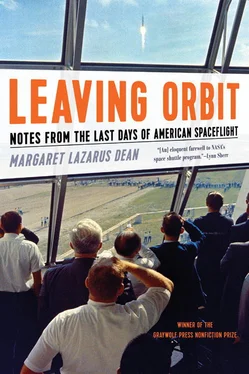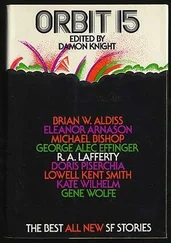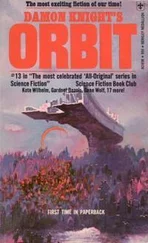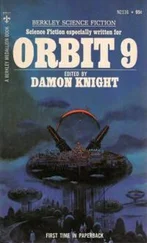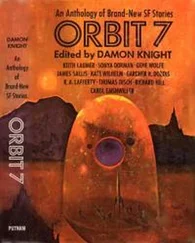I feel Omar materialize at my shoulder.
“What do you think?” he asks. I’m surprised by the hopeful tone in his voice, the expression on his face when I turn to meet his eyes. He is actually concerned that I might not be having a good time.
“It’s stunning,” I tell him. “I’m stunned.” He laughs before moving toward the mobile launch platform in one of the high bays. He tells me how the space shuttle launch vehicle is stacked vertically on the MLP before the crawler transporter lifts the whole business to move it slowly out to the launchpad. If Omar noticed I had tears in my eyes, he does an admirable job of not letting on. My father wanders over, and Omar explains more about how the platform works. My father snaps a picture of it.
The first segment of the first Saturn V reached the Vehicle Assembly Building in August 1966, and for the first time workers used the VAB’s full height to stack the vehicle’s stages one atop the other. I have a photo of the crew capsule being lowered onto the Saturn second stage, the Vehicle Assembly Building’s cranes being put to use for the first time. Workers, ridiculously tiny, stand upon the enormous cylinder of the second-stage rocket, heedless of the massive spacecraft dangling above their heads. I would love to have seen the VAB then, when it was new and first being put to its intended, and still fantastical, use. It took a full year to stack that first Apollo/Saturn. When the assembled vehicle was finally complete, the access doors opened almost the full height of the building, and Apollo 4 rolled majestically out, its bright black-and-white paint job visible for miles, as the spaceworkers who had built it sat on picnic blankets with their families and applauded.
Only since the collapse of the Soviet Union have we learned that the Soviets were in fact developing a moon rocket, known as the N1, in the sixties. All four launch attempts of the N1 ended in explosions. Saturn was the largest rocket in the world, the most complex and powerful ever to fly, and remains so to this day. The fact that it was developed for a peaceful purpose is an exception to every pattern of history, and this is one of the legacies of Apollo.
We pile back into Omar’s SUV and ride around to the other sites that are open to visitors. We visit the Orbiter Processing Facility, where the space shuttles are prepared horizontally before being rolled over to the VAB for stacking. We visit the launchpad where Discovery is poised nose up and ready to go. We see the Landing Facility and the mate/demate device, a ten-story contraption for lifting an orbiter onto and off of the 747 that ferries it back from California when it has to land there. We visit the Launch Control building, where on one wall of the seventies-style lobby are hung the mission patches of every human spaceflight that has ever been launched from here, 149 to date. Beneath each mission patch is a small plaque showing the launch and landing dates. Two of them— Challenger ’s STS-51L and Columbia ’s STS-107—are missing landing dates, because both of these missions ended in disasters that destroyed the orbiters and killed their crews. The blank spaces on the wall where those landing dates should have been are discolored from the touch of people’s hands. This would be unremarkable if this place were a tourist attraction, or regularly open to the public. But with the rare exception of Family Days, this building is open only to people who work here. In other words, it’s launch controllers, managers, and engineers who have been touching these empty spaces with their hands, on their way to and from doing their jobs.
After getting back on the road, we pass the Press Site, an agglomeration of buildings and decks centered around a large open field facing a body of water known as the Turn Basin, and beyond that, the launchpads. At the edge of the grassy field stands the huge countdown clock, the one you’ve seen in photos and news footage of launches, alongside an enormous flagpole flying an American flag. The buildings that belong to various news outlets have logos painted on them. I can make out only the ones closest to the road: CBS (whose Walter Cronkite narrated the iconic news coverage of the moon landings) and Florida Today. I crane my neck to see as much of the Press Site as I can, feeling a surprising jealousy of the people I see moving in and out of buildings there. They get access to people and places I can’t, even as Omar’s guest.
Near the Orbiter Processing Facility, Omar points out a gantry being constructed for Constellation, the program meant to follow the shuttle’s retirement. President George W. Bush had announced Constellation in 2004 with great fanfare—it is designed to be more modular and flexible than the shuttle program, allowing different boosters and different crew or cargo configurations for missions of varying lengths. The plan is to get astronauts and payloads into low Earth orbit again within ten years and, eventually, on to the moon, asteroids, and Mars.
But even at the time of the announcement, few people believed a second wave of moon landings could actually take place on anything resembling the schedule Bush described, a schedule that required future Congresses to increase NASA’s budget precipitously. Like many ambitious projects, it’s set up such that a future president and Congress will be forced to either foot the bulk of the cost or else kill the program, a time-honored way for politicians to claim credit for a bold move without having to pick up the tab. To no one’s surprise, President Obama announced in February 2010 that he planned to cancel Constellation and by doing so earned the ire of many NASA employees and spaceflight enthusiasts. That summer Congress voted to approve Obama’s NASA Authorization Act, a plan to increase NASA’s finding by $6 billion over five years, a continued commitment to support development of commercial capabilities in low Earth orbit, and a more streamlined long-range space vehicle, which would come to be called the Space Launch System. Constellation contracts would remain in place until Congress voted to overturn the previous mandate, leaving workers at the Cape to continue work that was almost sure to be undone sometime in the future. Obama’s bill also allowed for one more launch to be added, STS-135, on Atlantis , though this mission had yet to be funded and so was not certain to fly.
We drive to the Visitor Complex, an independently funded tourist attraction adjacent to the space center, and browse through the gift shop. There, while my father and Judy pick out space-themed gifts for my son, Omar and I stand shoulder to shoulder for a long time in the book department. He shows me the ones he likes (he’s read most of the books here), and I tell him about the ones I’ve read. He shows me the big-ticket items in the glass cases that he covets: detailed metal models of all five orbiters, signed glossy photographs of Apollo astronauts, space-flown medallions in jewel boxes.
“I’m surprised you know so much about Apollo, not just shuttle,” I say. Over the course of my day here I’ve learned to say “shuttle,” not “the shuttle,” when I’m referring to the entire program rather than a single vehicle.
“Oh, I’m interested in all of it,” Omar says. “Ever since I was a little kid. Maybe it’s because I grew up here and because my dad works here.”
“For some people, growing up with something like this makes it less interesting,” I say.
“That’s true,” Omar says thoughtfully. “I guess I’m lucky. The things I think are really cool are the things I get to see every day.”
Omar lets us use his employee discount to buy the things we’ve picked out. My father buys an astronaut suit and astronaut teddy bear for my son. I buy NASA T-shirts for my husband and son, a coffee mug for myself, books and key chains for friends. Omar gives me a mission patch from the most recent flight that he got from his father. Patches are sold in the gift shop as well, but this is one of the patches the NASA insiders give to their friends and families.
Читать дальше
